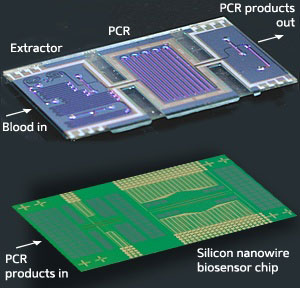| Dec 08, 2010 | |
Silicon nanowire device can detect dengue viruses in less than 30 minutes |
|
| (Nanowerk News) Dengue is an infection caused by one of four types of dengue viruses. Humans usually catch dengue from mosquitoes in tropical areas, particularly in Southeast Asia. The symptoms of dengue are very similar to those of influenza: infected individuals commonly experience headaches, rash and pain in muscles and joints. Some, however, may develop severe complications such as dengue hemorrhagic fever and dengue shock syndrome, which in extreme cases can be deadly. | |
 Photograph of the diagnostic device comprised of an extractor, a polymerase chain reaction (PCR) unit, and a silicon nanowire biosensor chip for the detection of dengue viruses. The incidence of dengue around the world has grown dramatically in recent years. The World Health Organization estimates that 50 million people catch dengue every year, and that 2.5 billion people are exposed the virus. Early detection of dengue viruses could help doctors implement timely clinical treatment and better manage infected patients, but the results of current diagnostic tests conducted in hospital laboratories can take up to several days to obtain. Guo-Jun Zhang at the A*STAR Institute of Microelectronics and co-workers ("Silicon nanowire biosensor for highly sensitive and rapid detection of Dengue virus") have developed a silicon nanowire-based biosensor that can detect the 'reverse transcription polymerase chain reaction' product of dengue type 2 (DEN-2) viruses in less than 30 minutes. The device utilizes silicon nanowires affixed with peptide nucleic acid (PNA) probes to recognize complementary DNA fragments of DEN-2. PNA is an artificially synthesized polymer similar to DNA but without phosphate groups, which allows it to bind DNA better than DNA itself due to the lack of electrostatic repulsion. In a typical test using the new device, researchers prepare complementary DNA fragments of the dengue viral RNA and then 'amplify' the number of fragments. The binding of complementary DNA fragments to the PNA probe is then detected by a change in charge and resistance of the silicon nanowire to which the PNA probe had been bound. |
|
| As a proof of concept, the researchers demonstrated that the device could be used to detect a complementary DNA fragment of DEN-2 that is 69 base pairs long. The detection time was less than 30 minutes, even when the concentration of DNA fragments was below ten femtomolars. They also demonstrated that the device was highly specific—only complementary DNA fragments of DEN-2 were recognized by the device in mixed samples. | |
| "Our silicon nanowire-based device will significantly reduce the reliance on labor-intensive and time-consuming laboratory tests requiring trained laboratory staff," says Zhang. | |
| The results highlight the potential of silicon nanowire-based devices in the diagnosis of dengue viruses. The researchers plan to integrate their device into handheld diagnostic systems. |
| Source: A*STAR |
